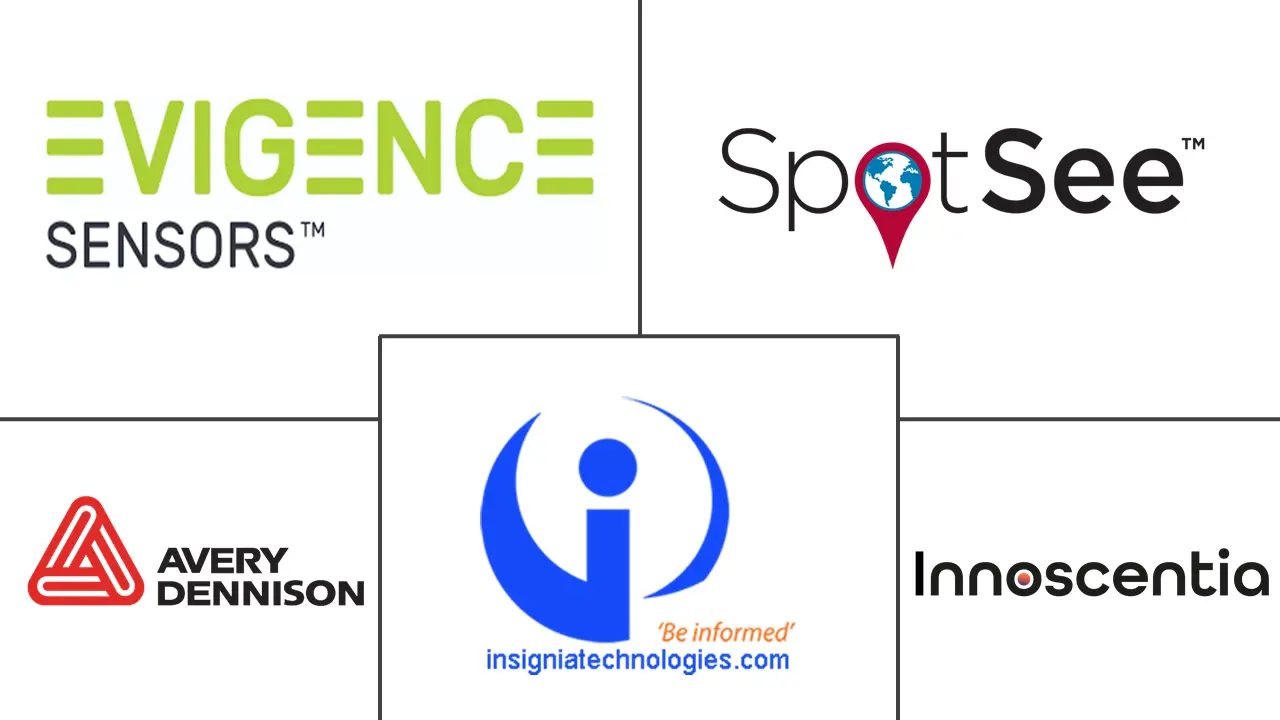Spoil Detection-based Smart Labels Market Size and Share
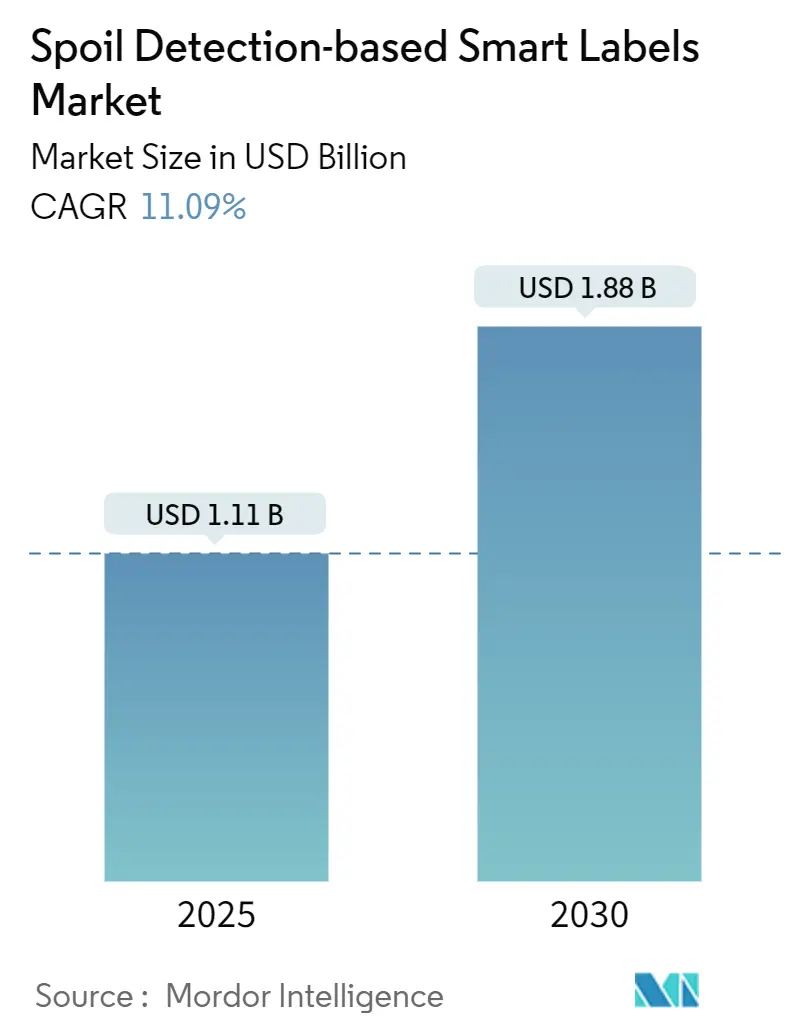
Spoil Detection-based Smart Labels Market Analysis by Mordor Intelligence
The Spoil Detection-based Smart Labels Market size is estimated at USD 1.11 billion in 2025, and is expected to reach USD 1.88 billion by 2030, at a CAGR of 11.09% during the forecast period (2025-2030).
The Spoil Detection-based Smart Labels Market is undergoing significant transformation driven by digitalization and an increasing emphasis on supply chain transparency. Smart labels are becoming increasingly sophisticated, incorporating technologies such as RFID, sensing labels, and NFC to provide real-time monitoring capabilities. These innovations are particularly crucial in the pharmaceutical sector, where, according to IBEF, India ranks third globally in pharmaceutical production by volume, highlighting the massive potential for smart label adoption in drug safety and authenticity verification. The integration of blockchain technology with smart labels has emerged as a game-changing development, enabling secure tracking of products throughout their journey and significantly enhancing consumer confidence.
The industry is witnessing a paradigm shift toward sustainable packaging solutions and waste reduction initiatives. Major retailers and manufacturers are implementing smart labeling solutions to address the growing concerns about food waste and product authenticity. According to Nestlé India's projections, the packaged food industry is expected to double to USD 70 billion in the next 5-10 years, creating substantial opportunities for smart label integration. This growth is accompanied by increasing regulatory oversight, with countries implementing stricter food safety and labeling requirements to ensure product quality and reduce waste throughout the supply chain.
Technological innovations in sensor technology and materials science are revolutionizing the smart label landscape. Companies are developing advanced sensing capabilities that can detect multiple parameters simultaneously, including temperature, humidity, and bacterial growth. The integration of printed electronics and flexible sensors has enabled the creation of more cost-effective and versatile smart labels. These innovations are particularly relevant in addressing health concerns, especially in regions like China where, according to the National Health Commission report, more than 50% of adults are classified as overweight, driving demand for better food quality monitoring solutions. The incorporation of time-temperature indicator labels is becoming increasingly vital in ensuring the freshness and safety of perishable goods.
The market is experiencing significant developments in supply chain optimization through smart label integration. Major food retailers and pharmaceutical companies are adopting comprehensive tracking solutions that combine multiple technologies to ensure product integrity throughout the distribution process. The industry is seeing increased collaboration between technology providers, packaging companies, and end-users to develop integrated solutions that address specific industry challenges. These partnerships are focusing on creating more affordable and scalable smart label solutions that can be implemented across various product categories while maintaining effectiveness and reliability. The time-temperature indicator labels market is poised for growth as these solutions become more integral to maintaining product quality.
Global Spoil Detection-based Smart Labels Market Trends and Insights
Rising Need to Determine the Freshness of Products
The increasing consumer preference for convenience food items is significantly driving the demand for spoil detection smart labels, primarily due to the shift toward a healthy lifestyle and the higher purchasing power of consumers. Products like salad bags, fresh herb packs, chopped vegetable bags, vegetable trays, and single-serve salad packaging require reliable freshness monitoring solutions. According to the Food and Agriculture Organization (FAO), approximately 33% of food is wasted globally in the supply chain, while the European Commission reports that over 40% of food products are wasted before reaching retail markets. These alarming statistics have prompted manufacturers to increasingly adopt spoil detection labels that can track product freshness in real-time.
Smart labels are revolutionizing how freshness is monitored through innovative technologies like time-temperature indicator labels, freshness indicators, and modified atmosphere packaging (MAP). These technologies can double the shelf life of perishable goods and significantly reduce food wastage. For instance, some manufacturers use smart labels incorporated with necessary sensors to collect important data about their product usage and transport conditions. The labels can change color or texture to indicate freshness levels, while some communicate directly with systems through RFID tags to provide real-time monitoring capabilities. This technological advancement has enabled food companies to connect with consumers by offering additional nutritional and ingredient information while helping combat food wastage through improved tracking and monitoring systems.
Rising Consumer Preference for Hygiene of Food Material
The increasing consumer preference for hygienic foods has created a substantial demand for frozen and processed products that require less time and effort than cooking from scratch. Smart food labels are increasingly utilized by food manufacturers to improve traceability, product information, hygiene of food materials, and food safety. According to the World Health Organization, around 600 million people worldwide fall ill after eating contaminated food, highlighting the critical importance of maintaining food hygiene standards. The information provided by smart labels is highly beneficial for food recalls, allowing manufacturers and consumers to quickly identify contaminated food and its batch information and take measures accordingly.
Smart RFID technology is being extensively deployed in food materials to track the hygiene of food materials for consumer experiences, increase inventory visibility, reduce shrinkage, and boost brand protection. Some RFID inlays are specifically designed to be readable on liquid-containing and metallic-embellished packaging, increasing inventory accuracy and aiding loss prevention. These labels are not just used for hygiene monitoring but also find applications in wines and beverages for engaging consumer experiences and providing extra protection against counterfeiting and refilling. The implementation of such advanced labeling solutions has shown remarkable improvements in inventory accuracy, with some solutions improving accuracy rates from 30-70% to as high as 99.8%.
Increasing Demand for Security and Tracking Solutions
The issues related to security against theft and counterfeiting are crucial to any industry, particularly as enterprises worldwide establish more direct selling chains. Smart labels serve not just as anti-theft devices but also as sophisticated tracking tools with embedded smart chips enabling real-time location monitoring. These solutions provide businesses with comprehensive location and tracking services to locate their assets in real-time, depending on their supporting IT and technology infrastructure. The reusability of these smart labels and tags offers a cost-effective solution for industry end-users, providing enhanced security and monitoring capabilities throughout the supply chain.
Understanding the incoming and outgoing flow of raw materials in industries and maintaining track marks has become crucial for meeting business goals and ensuring consumer satisfaction. The technology has evolved to offer enhanced security features, such as rack and container tracking solutions with increased visibility to manage highly complex operations and optimize costs better. For instance, some manufacturers are using smart labels with integrated sensors to collect vital data about product usage and transport conditions, enabling them to maintain product integrity throughout the supply chain. These advanced tracking solutions have proven particularly valuable in industries where product authenticity and security are paramount, such as pharmaceuticals and high-value consumer goods, where they help combat counterfeiting while providing end-to-end supply chain visibility.
Segment Analysis
RFID Segment in Spoil Detection-based Smart Labels Market
The RFID segment holds a dominant position in the spoil detection-based smart labels market, driven by its widespread adoption across multiple industries, including food and beverage, pharmaceuticals, and retail. RFID technology enables unique traceability per product without requiring direct line of sight for data reading, resulting in enhanced supply chain visibility and logistics processes. This automation significantly reduces errors, unknown losses, and out-of-stock situations while simplifying inventory management and purchasing forecasting. The technology's ability to integrate sensors with RFID tags for monitoring temperature, freshness, and product quality has made it particularly valuable in cold chain applications and perishable goods tracking. Major retailers and pharmaceutical companies are increasingly implementing RFID-based smart labels for improved inventory accuracy and product authentication.
Sensing Label Segment in Spoil Detection-based Smart Labels Market
The sensing label segment is experiencing rapid growth in the spoil detection-based smart labels market, driven by continuous innovations in printed sensor technologies and increasing demand for real-time quality monitoring solutions. These labels incorporate various sensing technologies, including optical, ultrasonic, and capacitive sensors, that can detect multiple parameters such as temperature, moisture, movement, and product freshness. The segment's growth is further accelerated by advancements in thin-film technology and the development of more sophisticated sensing capabilities that can provide accurate information about product conditions. Companies are actively investing in research and development to enhance the durability and reliability of sensing labels, particularly for applications in harsh environments and temperature-sensitive products.
Remaining Segments in Technology Segmentation
The NFC segment represents another significant technology in the spoil detection-based smart labels market, offering unique advantages in terms of consumer engagement and product authentication. NFC labels can carry more data than traditional barcodes or QR codes and provide access to virtually unlimited additional information through smartphone connectivity. This technology is particularly valuable in the pharmaceutical and luxury goods sectors, where authentication and patient/consumer safety are paramount concerns. The integration of NFC with other smart label technologies is creating new possibilities for enhanced product tracking, consumer interaction, and brand protection solutions.
Segment Analysis: By End-User Industry
Food and Beverage Segment in Spoil Detection-based Smart Labels Market
The food and beverage segment dominates the spoil detection-based smart labels market, holding approximately 53% market share in 2024. This significant market position is driven by increasing consumer awareness about food safety and the rising need to determine product freshness in real-time. The segment's growth is particularly notable in applications such as meat and poultry products, dairy items, and packaged foods where freshness monitoring is crucial. Major retailers and food manufacturers are increasingly adopting these smart labels, including time-temperature indicator labels, to enhance their supply chain visibility and reduce food waste. The implementation of these labels has shown promising results, with some companies reporting up to a 20% reduction in date-expired food waste and a 50% reduction in labor costs through improved inventory management.
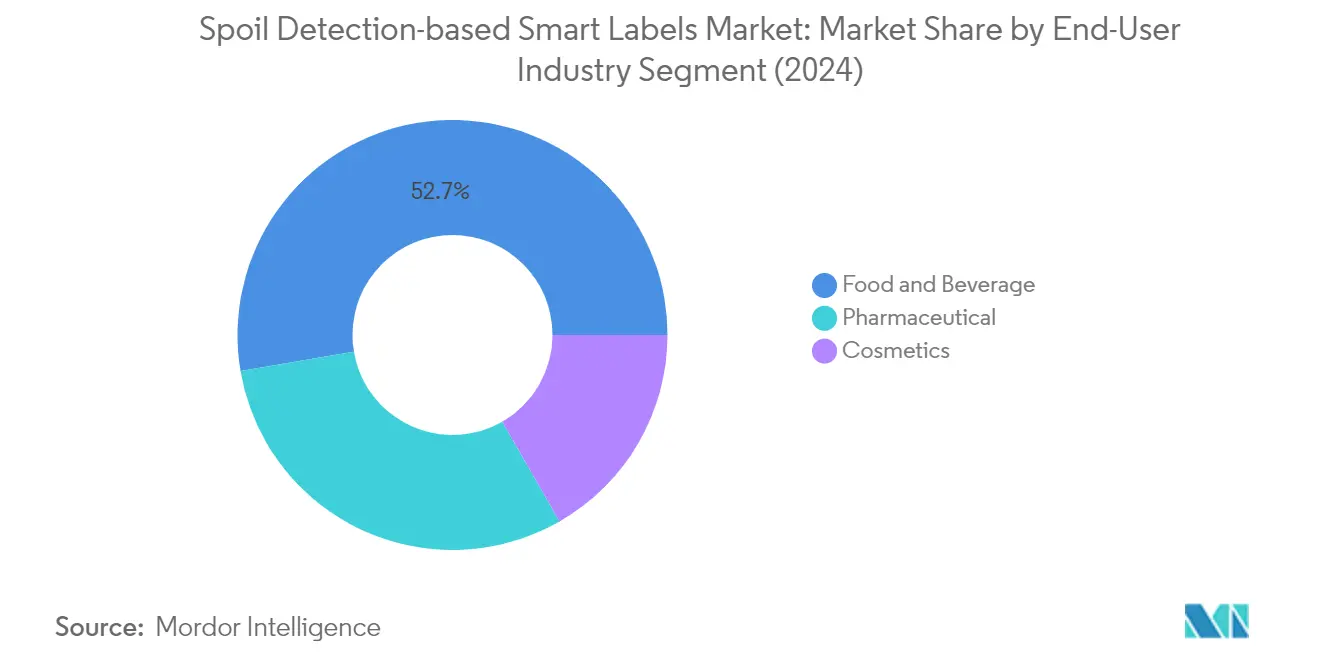
Pharmaceutical Segment in Spoil Detection-based Smart Labels Market
The pharmaceutical segment is projected to exhibit the highest growth rate of approximately 11% during the forecast period 2024-2029. This accelerated growth is primarily attributed to stringent regulations regarding drug safety and the critical need for temperature monitoring in pharmaceutical supply chains. The segment is witnessing increased adoption of smart labels for vaccine vials, biological drugs, and temperature-sensitive medications. Healthcare facilities and pharmaceutical companies are increasingly implementing these solutions, including time-temperature indicator labels, to ensure product integrity and comply with regulatory requirements. The integration of RFID technology with spoil detection capabilities is particularly gaining traction in this segment, as it enables real-time monitoring of drug conditions throughout the supply chain.
Remaining Segments in End-User Industry
The cosmetics segment plays a vital role in the spoil detection-based smart labels market, particularly in addressing the challenges of product authenticity and shelf-life monitoring. This segment is seeing increased adoption of smart labels for premium beauty products and sensitive formulations that require specific storage conditions. The integration of these labels helps cosmetic manufacturers maintain product quality throughout the distribution chain while also providing consumers with real-time information about product freshness. The segment is particularly focused on implementing anti-counterfeiting measures and ensuring product authenticity, which has become crucial in the global cosmetics market.
Geography Analysis
Spoil Detection-based Smart Labels Market in North America
North America represents a mature regional segment for spoil detection-based smart labels market, driven by advanced retail infrastructure, stringent food safety regulations, and high consumer awareness regarding food wastage. The United States and Canada are the key markets in this region, with both countries showing strong adoption across pharmaceutical, food and beverage, and cosmetics sectors. The region's growth is supported by the presence of major retail chains and their increasing focus on implementing smart packaging solutions for better inventory management and consumer safety. The integration of time-temperature indicator (TTI) labels in these solutions further enhances the effectiveness of spoil detection.
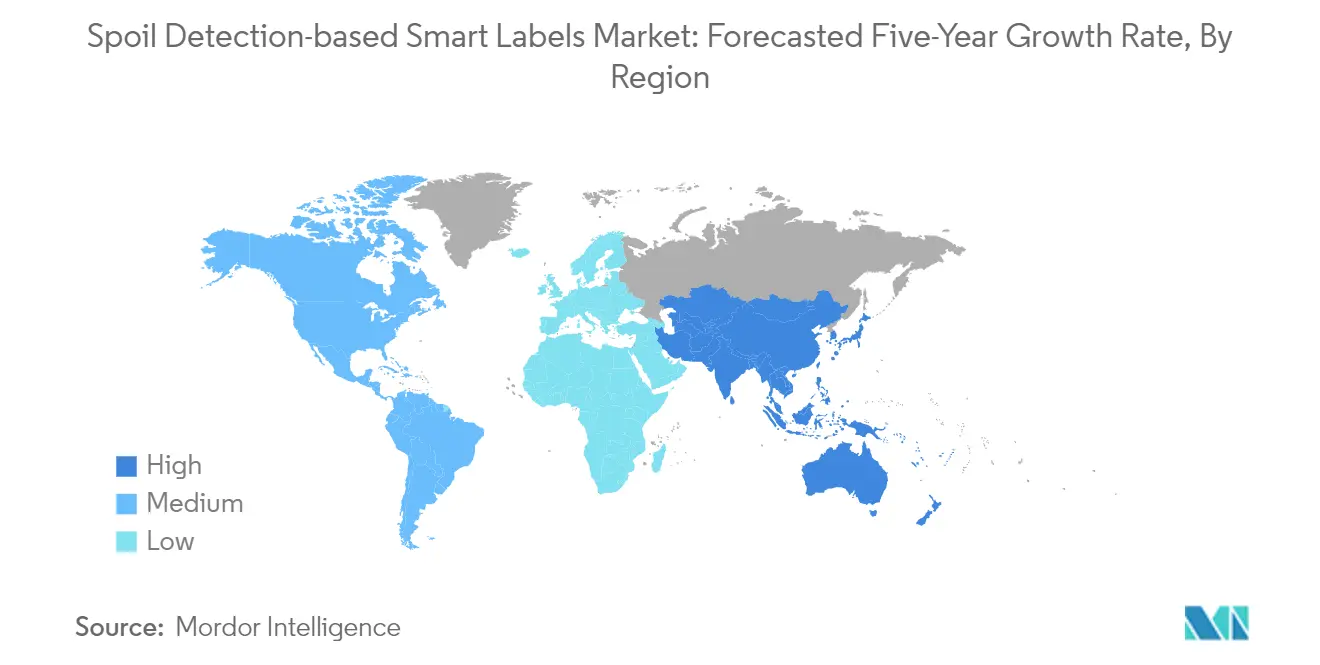
Spoil Detection-based Smart Labels Market in United States
The United States dominates the North American market, holding approximately 78% market share in 2024. The country's market is characterized by the vast presence of retail stores, both small and large, led by retail giants like Walmart. The increasing adoption of smart labels is driven by growing concerns over food security and wastage, with technology proliferation allowing smart labels to predict freshness and help consumers understand product quality. The country's healthcare sector is also witnessing increased deployment of these labels, particularly in pharmaceutical packaging and medical supply chain management. The time-temperature indicator labels market is gaining traction as a critical component in ensuring product quality and safety.
Spoil Detection-based Smart Labels Market in Canada
Canada is emerging as the fastest-growing market in North America, with a projected growth rate of approximately 10% from 2024-2029. The country's market is driven by various government initiatives aimed at reducing food waste and improving food safety standards. The effects of new advancements in digital technologies have influenced the Canadian printing industry, making it more competitive and encouraging firms to invest in smart label solutions. The market is characterized by the presence of several global and regional players, with an increasing focus on new product development and strategic partnerships to expand market presence. The adoption of TTI labels is a key trend, enhancing the functionality of smart packaging solutions.
Spoil Detection-based Smart Labels Market in Europe
The European market for spoil detection-based smart labels is characterized by strong regulatory frameworks and increasing adoption across various industries. Germany, France, and the United Kingdom are the key markets in this region, each contributing significantly to the overall market growth. The region's market is driven by various initiatives aimed at reducing food waste, improving supply chain transparency, and ensuring product authenticity across industries.
Spoil Detection-based Smart Labels Market in Germany
Germany leads the European market with approximately 30% market share in 2024. The country's strong position is attributed to its robust pharmaceutical and food and beverage sectors, coupled with government initiatives aimed at reducing food wastage. The Federal Ministry of Food and Agriculture's focus on reducing food waste through innovative packaging solutions has been a key driver for market growth. The country also benefits from the presence of several major manufacturers and service providers in the pharmaceutical industry, creating substantial opportunities for smart label deployment.
Spoil Detection-based Smart Labels Market in France
France represents the fastest-growing market in Europe, with a projected growth rate of approximately 10% from 2024-2029. The country's market is particularly driven by the retail sector's need to combat shrinkage and improve inventory management. French authorities' commitment to reducing food waste has led to various initiatives that promote the adoption of smart packaging solutions. The increasing adoption of Industry 4.0 practices and smart factory concepts is further accelerating the implementation of smart labeling solutions across various industries.
Spoil Detection-based Smart Labels Market in Asia-Pacific
The Asia-Pacific region represents a dynamic market for spoil detection-based smart labels, with significant growth potential across various sectors. China, Japan, and India are the key markets driving regional growth, each with its unique market characteristics and adoption patterns. The region's market is characterized by rapid urbanization, increasing consumer awareness about food safety, and growing adoption of smart packaging solutions across various industries.
Spoil Detection-based Smart Labels Market in China
China leads the Asia-Pacific market as the largest country in terms of market size. The demand for spoil detection-based smart labels is gaining prominent traction in China, driven by rapid urbanization and higher consumer income levels. The country's market is particularly strong in retail and food and beverage applications, with significant adoption in tracking and authenticating products throughout the supply chain. The presence of major retail players and e-commerce platforms has further accelerated the adoption of these smart labeling solutions.
Spoil Detection-based Smart Labels Market in India
India emerges as the fastest-growing market in the Asia-Pacific region. The country's market is driven by the rapid growth of the packaged food industry, pharmaceutical sector, and e-commerce platforms. Several changes are shaping the Indian food landscape, primarily characterized by a shift in consumer buying patterns, lifestyle changes, and growing awareness of hygiene-conscious products. The presence of global players establishing manufacturing facilities and innovation centers in India is further accelerating market growth.
Spoil Detection-based Smart Labels Market in Latin America
Latin America presents significant opportunities for spoil detection-based smart labels, particularly in the food and pharmaceutical sectors. The region is characterized by its rich production of raw materials and food goods, with increasing industrialization driving the adoption of new, more sustainable technologies. The market is particularly strong in countries with large meat processing industries and growing pharmaceutical sectors. The move toward self-sufficiency in pharmaceutical production and the evolution of e-commerce platforms are creating new opportunities for smart label adoption across the region, with Brazil emerging as both the largest and fastest-growing market in the region.
Spoil Detection-based Smart Labels Market in Middle East & Africa
The Middle East & Africa region shows growing potential for spoil detection-based smart labels, particularly in the cosmetics and food sectors. The market is driven by increasing consumer awareness, growing retail infrastructure, and rising demand for product authentication solutions. Saudi Arabia leads the market size in the region, particularly in the cosmetics sector, while South Africa shows the fastest growth potential, driven by its expanding poultry industry and increasing adoption of smart packaging solutions in the food sector. The region's growth is supported by the increasing demand for halal and vegan products, which require stringent tracking and authentication measures.
Competitive Landscape
Top Companies in Spoil Detection-based Smart Labels Market
The competitive landscape is characterized by continuous product innovation focused on enhancing detection accuracy and integration capabilities. Companies are heavily investing in research and development to create advanced sensor technologies and smart packaging solutions that can effectively monitor product freshness and spoilage. Strategic partnerships, particularly with technology providers and packaging manufacturers, have become increasingly common to strengthen market positions and expand product offerings. Operational agility is demonstrated through the development of customizable solutions that cater to specific industry requirements, especially in the pharmaceutical and food sectors. Market leaders are expanding their geographical presence through both organic growth and strategic acquisitions, while simultaneously focusing on developing sustainable and cost-effective smart label solutions.
Dynamic Market with Strong Growth Potential
The market structure exhibits a mix of global conglomerates and specialized technology providers, with companies like Avery Dennison and SpotSee maintaining significant market presence through their comprehensive product portfolios and extensive distribution networks. The industry is moderately consolidated, with established players leveraging their technological expertise and brand reputation to maintain market positions. Regional specialists like Evigence Sensors and Insignia Technologies are carving out niches through focused innovation in specific application areas, while larger corporations are expanding their capabilities through strategic acquisitions and partnerships.
Merger and acquisition activities are primarily driven by the need to acquire new technologies and expand geographical reach, with major players actively seeking to integrate complementary capabilities into their existing portfolios. The market is witnessing increased collaboration between traditional label manufacturers and technology companies to develop integrated solutions that combine sensing capabilities with advanced communication technologies. This trend is particularly evident in the food and pharmaceutical sectors, where companies are forming strategic alliances to address growing demand for sophisticated spoilage detection solutions, including time-temperature indicator labels.
Innovation and Adaptability Drive Market Success
Success in this market increasingly depends on the ability to develop cost-effective, reliable, and easily integrable solutions that meet specific industry requirements. Incumbent companies are focusing on expanding their technology portfolios through internal development and strategic partnerships, while also strengthening their distribution networks to maintain market dominance. The ability to provide end-to-end solutions, from sensor technology to data analytics and integration with existing systems, is becoming a crucial differentiator for market leaders. Companies are also investing in sustainable solutions and eco-friendly materials to address growing environmental concerns and regulatory requirements.
For contenders looking to gain market share, specialization in specific industry verticals or technological niches offers a viable path to growth. The market presents moderate substitution risks, primarily from traditional labeling solutions, but the increasing demand for real-time monitoring and traceability continues to drive adoption of smart labels, including time-temperature indicator (TTI) labels. Regulatory compliance, particularly in food safety and pharmaceutical applications, plays a crucial role in shaping product development and market strategy. Companies that can demonstrate consistent performance, reliability, and compliance with industry standards while maintaining competitive pricing are better positioned for long-term success.
Spoil Detection-based Smart Labels Industry Leaders
-
Evigence Sensors
-
Insignia Technologies
-
Avery Dennison Corporation
-
Innoscentia
-
SpotSee
- *Disclaimer: Major Players sorted in no particular order
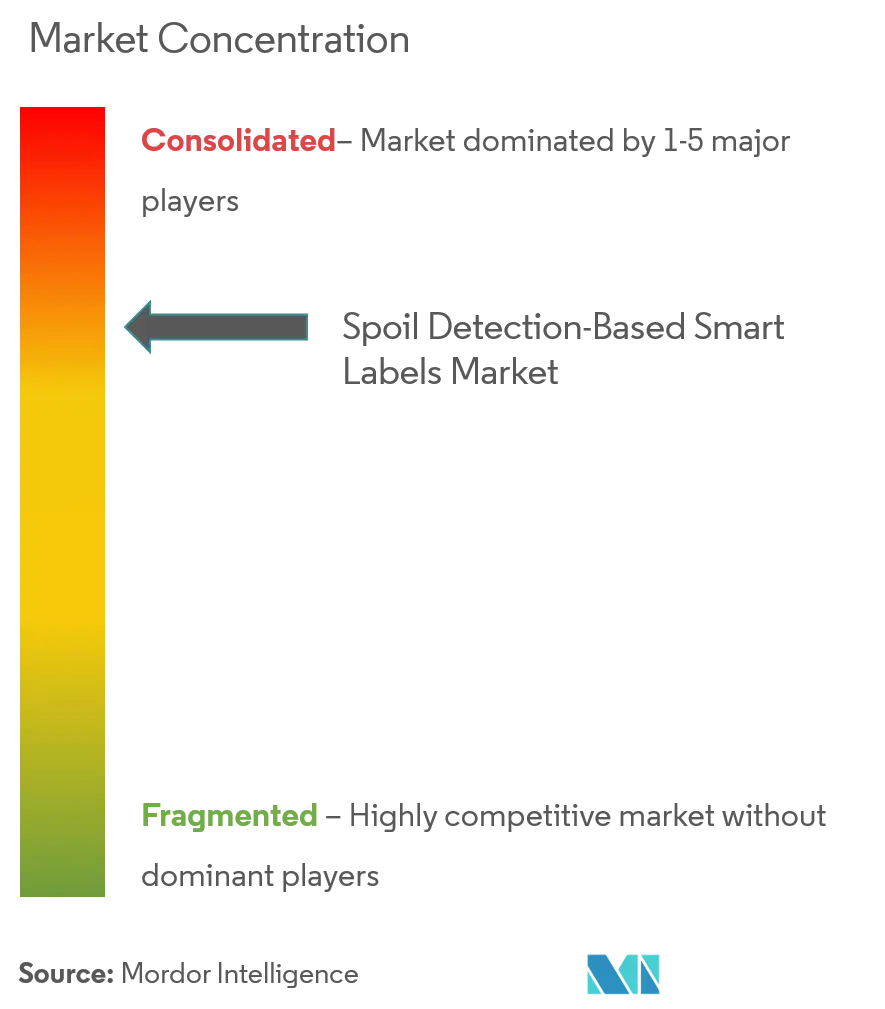
Recent Industry Developments
- April 2022: Avery Dennison, one of the leaders in global materials science and manufacturing, to commence operations in its new state-of-the-art manufacturing facility in Greater Noida. Through this new facility, the company will consolidate its manufacturing operations to serve customer demands better while optimizing the latest technology and leveraging improved efficiencies.
- April 2022: SpotSee, one of the global leaders in supply chain temperature indicators that protect life sciences products against damage and ensure supply chain integrity, launched FreezeSafe. This new low-cost temperature indicator accurately shows if a product has experienced unacceptably low temperatures. Requiring only a quick visual check, FreezeSafe is easy to read and ready to use. In addition, the indicator comes in two different temperature thresholds, 0°C, and 2°C. The easy-to-implement device can be added to every shipment or mounted directly onto a product.
- December 2021: SpotSee announced the launch of its new temperature-monitoring device, the Vaccine Vial Indicator, which is designed to help maintain the cold vaccine chain. The indicator provides clear evidence of whether the temperatures have been exceeded before administration.
- September 2021: Timestrip UK Limited launched a new vaccine temperature indicator to avoid the wastage of vaccine supplies. The vaccine freezer monitor 'VFM -7C' follows the temperature precisely and shows a clear alert if temperatures rise above -7C. It also has a built-in window showing the breach's duration up to 72 hours.
Global Spoil Detection-based Smart Labels Market Report Scope
Spoil detection-based smart labels detect the freshness of a product and have found applications across various end-user industries. The Spoil Detection-based Smart Labels Market report segments the market by technology (RFID, sensing labels, and NFC), by end-user industry (pharmaceutical, food, and cosmetics), and geography
A smart label is an item identification slip that contains more advanced technologies than conventional bar code data. Smart labels give easy and instantaneous access to detailed information about thousands of products. The most common enhancements in smart labels are QR codes, electronic article surveillance (EAS) tags, and specially configured RFID tags.
| RFID |
| Sensing Label |
| NFC |
| Pharmaceutical |
| Food and Beverage |
| Logistics |
| Cosmetics |
| Other End-user Industries |
| North America | United States |
| Canada | |
| Europe | Germany |
| United Kingdom | |
| France | |
| Rest of Europe | |
| Asia-Pacific | China |
| Japan | |
| India | |
| Rest of Asia-Pacific | |
| Latin America | |
| Middle-East and Africa |
| Technology (Qualitative Trend Analysis) | RFID | |
| Sensing Label | ||
| NFC | ||
| End-user Industry | Pharmaceutical | |
| Food and Beverage | ||
| Logistics | ||
| Cosmetics | ||
| Other End-user Industries | ||
| Geography | North America | United States |
| Canada | ||
| Europe | Germany | |
| United Kingdom | ||
| France | ||
| Rest of Europe | ||
| Asia-Pacific | China | |
| Japan | ||
| India | ||
| Rest of Asia-Pacific | ||
| Latin America | ||
| Middle-East and Africa | ||
Key Questions Answered in the Report
How big is the Spoil Detection-based Smart Labels Market?
The Spoil Detection-based Smart Labels Market size is worth USD 1.11 billion in 2025, growing at an 11.09% CAGR and is forecast to hit USD 1.88 billion by 2030.
What is the current Spoil Detection-based Smart Labels Market size?
In 2025, the Spoil Detection-based Smart Labels Market size is expected to reach USD 1.11 billion.
Which is the fastest growing region in Spoil Detection-based Smart Labels Market?
Asia Pacific is estimated to grow at the highest CAGR over the forecast period (2025-2030).
Which region has the biggest share in Spoil Detection-based Smart Labels Market?
In 2025, the North America accounts for the largest market share in Spoil Detection-based Smart Labels Market.
What years does this Spoil Detection-based Smart Labels Market cover, and what was the market size in 2024?
In 2024, the Spoil Detection-based Smart Labels Market size was estimated at USD 0.99 billion. The report covers the Spoil Detection-based Smart Labels Market historical market size for years: 2019, 2020, 2021, 2022, 2023 and 2024. The report also forecasts the Spoil Detection-based Smart Labels Market size for years: 2025, 2026, 2027, 2028, 2029 and 2030.
Page last updated on:
